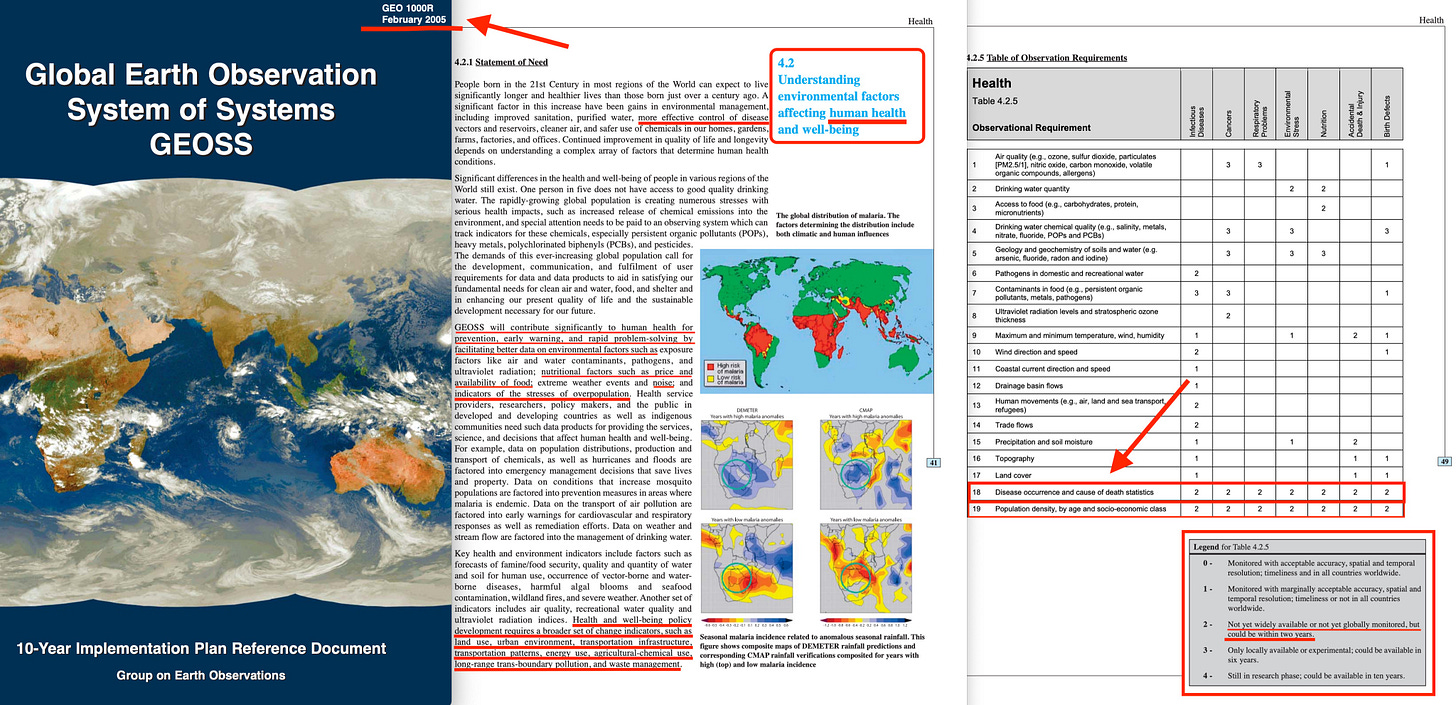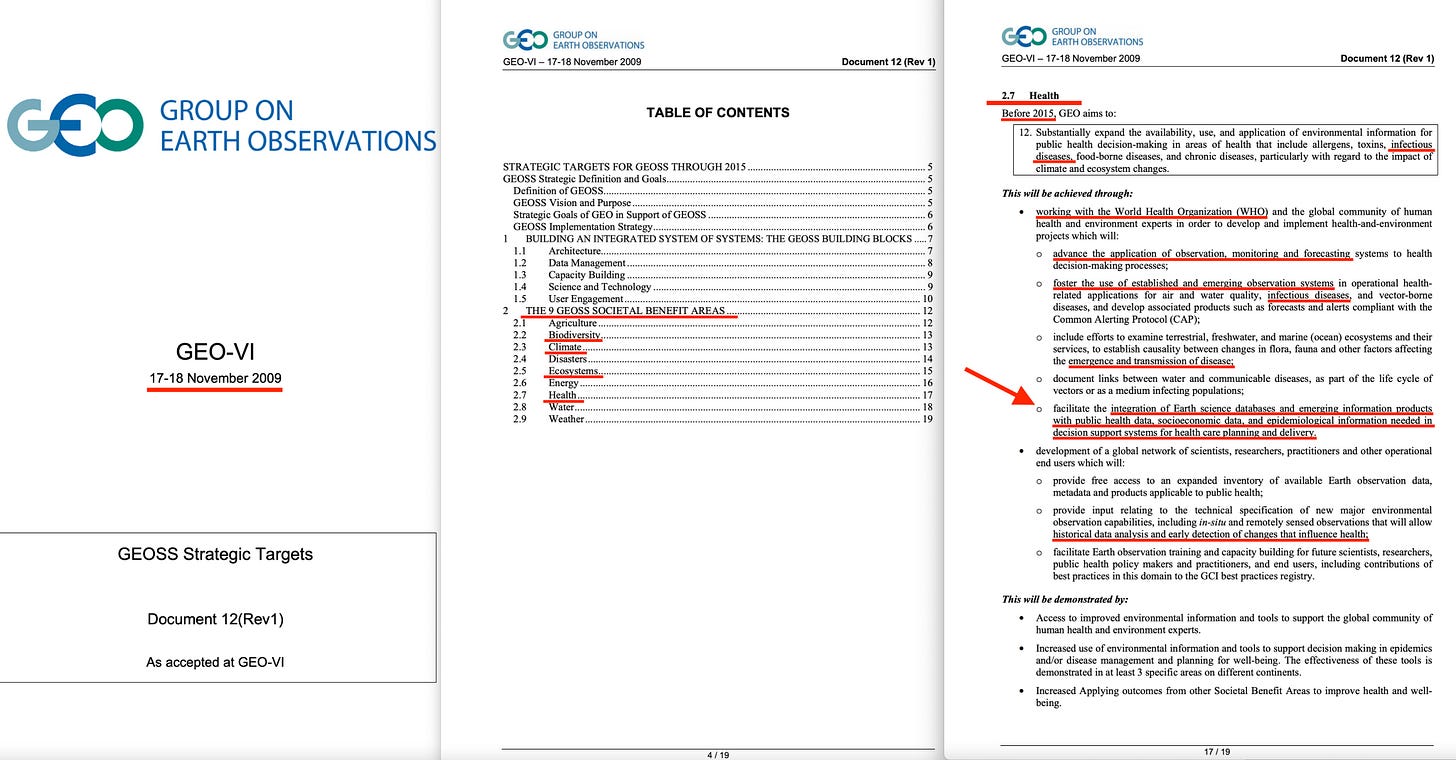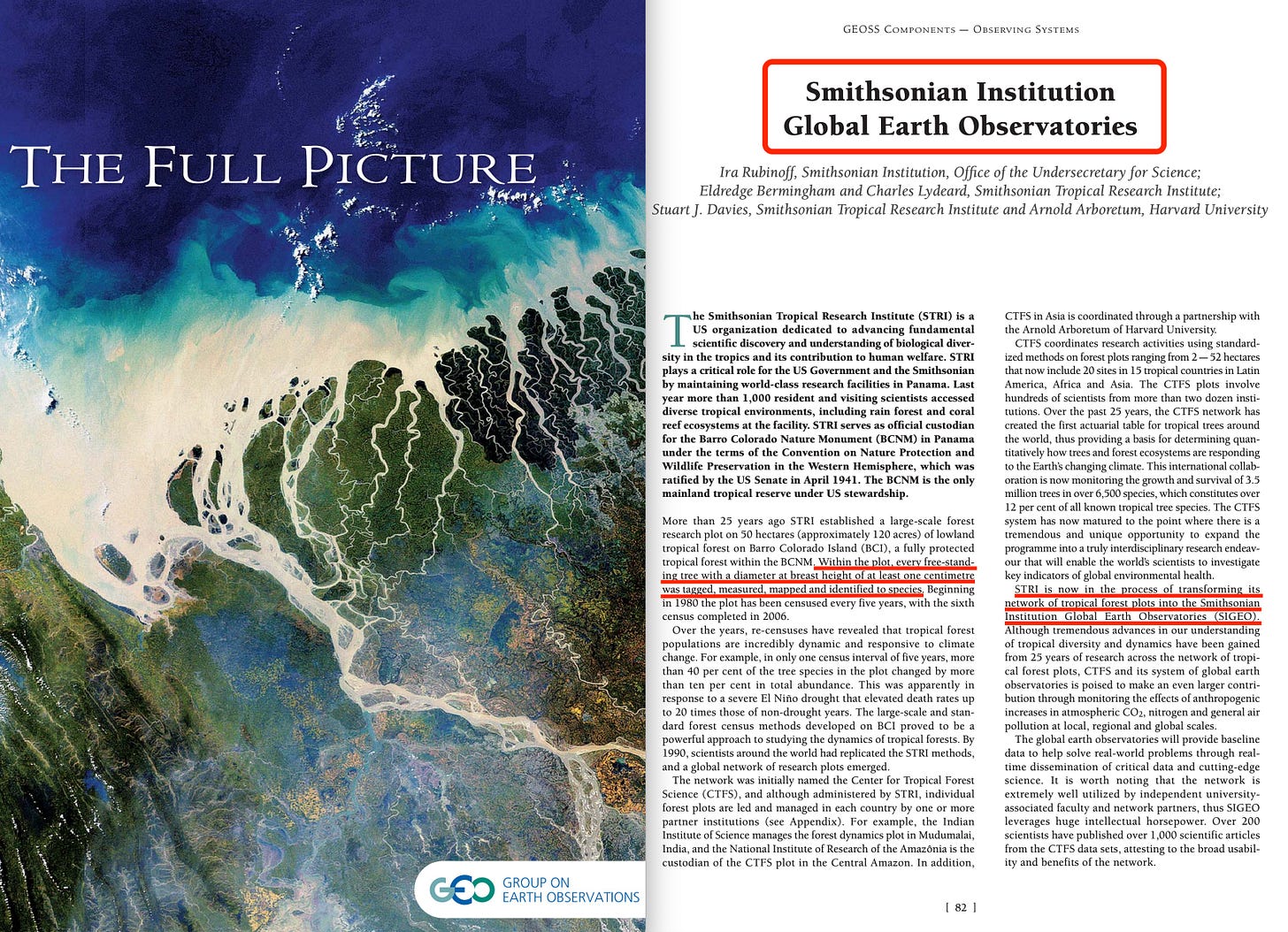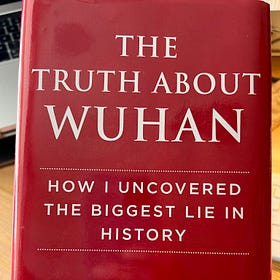GEOSS & The Canberra Declaration
Somewhere along the line, GEMS disappeared. One day, practically every statesman and United Nations initiative declared not just full support of the Global Environmental Monitoring System, but in fact demanded it strengthened.
This is the story of what happened to GEMS, and how GEOSS rose from its ashes.
-
I have covered GEMS rather a lot as of late. I have also covered the 12 principles of the Convention on Biological Diversity, because those will obviously require input data from the GEMS programs to push through their insane ideology, which I outlined in the below, ‘The Ecosystem Approach’.
The Ecosystem Approach
It took me months to fully decipher the Manhattan Principles, aka One Health. Primarily because individual principles are heavily encoded with the typical, grossly intellectually dishonest doublespeak we’ve come to love so much during the scamdemic. And deciphering is often a matter of locating an obscure paragraph in a 40 year old document, unlocking y…
But one thing I potentially got wrong, was assuming GEMS was still ongoing. Because while scattered initiatives - such as GEMS/Water and GEMS/Food - still appear to be active, what’s really of interest here is not so much the 33 or so GEMS programs at last count in the 1990s - of which water and food are just two - but what they do with the data. And that’s where we kick off today’s story.
And in that regard, as most of this information is clearly not distributed along the usual lines of supporting ‘transparency’ (through their information clearinghouses, sure to censor ‘incorrect’ and information considered ‘missing’ its ‘context’) and fraudulent promises of ‘the people have a right to know‘ (so that they can sue the state in the name of ‘climate justice’), piecing together the full picture is pretty difficult.
We do know that GEMS was outlined in the 1987 Brundtland report, along with explicit inclusion in the Agenda 21 texts.
We also see, in this document from 1995, that Earthwatch is considered of importance, and that all relevant UN agencies should participate closely in the construction of an ‘integrated system of information for decision-making, as recommended in Agenda 21’
And then we have this, from early 1997, and Clinton’s White House. ‘The United States also continued its support for UNEP's scientific monitoring and assessment, Earthwatch, through participation in several of its programs, in particular, the Global Resource Database (GRID), the Global Environmental Monitoring System (GEMS Air and Water) and the environmental information retrieval system (INFOTERRA)‘
GRID is a component of GEMS, and GEMS is a part of Earthwatch. It all appear happy days at this stage. And make a note of this being released after Clinton’s announcement on Global Surveillance, but before the Department of Defense announce the launch of the GEIS.
DoD GEIS deserves a mention, due to significance - I covered it previously in this article.
The Department of Defense
In the article posted yesterday, I told you to pay attention to Goal 8. Because in this short space, we have - The Department of Defense (DoD) will include support of global surveillance. The DoD will step up overseas involvement with overseas laboratories
But dig a little further…
In 1996, the talk centered about GEMS being outpaced by technological revolution, and GEMS being integrated into a number of Global Observing Systems is revealed in the document from 2000.
In 2003, Washington DC hosts the first Earth Observation Summit. I could detail this, but let’s just focus on two associated documents - the IGOS background, and the Draft Declaration. Because the former explicitly outline the participation of the above Global Observing Systems, and the latter outline the initiative - ‘Preparation of a 10-year plan for the implementation of a comprehensive, coordinated and sustained Earth observation system,‘
We’ll get to the 10 year plan in a minute, because it’s fairly indicative of intent, and chronologically, it only becomes even worse as we close in on 2019, and Canberra.
The 10 year plan can be found here, outlining their 2005-2015 plan.
GEOSS, 2005. 4.2 outline a specific ‘global good’ - HEALTH. Oh yeah, and indicators of the stresses of overpopulation. They also feature a detailed breakdown of diseases, and when these can be plugged into the system, which in all instances appear to be within 2 years.
Again, I could dive into further detail, but unsure if there’s a need. The point is to draw attention to health very much being a considered, specific component already from launch. Goalposts will obviously be moved as we go along.
In 2007, this update was produced from their meet in Cape Town.
… and 2009 brought up this update, which includes '... integration of Earth science databases and emerging information products with public health data, socioeconomic data, and epidemiological information needed in decision support systems for health care planning and delivery'
And fast forward to 2015 where we saw this release, which… interestingly starts to drag in the Smithsonian Institute. I find this a very, very interesting development, not just because of Robert Malone’s off the cuff remark in his super-ackward interview with AG Huff, who I personally is pretty damn sure is not who he claims to be.
I previously covered AG Huff here.
Beware of False Prophets, like Andrew G Huff
So who here has read this swashbuckling tale, one in which our hero - Andrew G Huff - faces up to gain-of-function evil? I would add ‘unsung’, but I feel as though that would smear it a bit thick, as he’s song his own praises rather well enough especially in the book’s 20th chapter; ‘
There are a further documents I could add here, but instead, let’s change the topic. Have you ever heard of the Canberra Declaration? No? Well, here it is.
Wait, no - that’s not the one. No, here it is.
No, that’s not quite right. Wait, no, no, here it is. This time I’ve got it, right?
Sheesh…. how about this one - is this it?
But of course it isn’t. In fact, here it is. You can find it on Google, still fresh in the cache. Except, of course, you know what’s coming. That’s right, the entire GEOSS page was mysteriously removed.
In fact, they took it down very, very recently. Here’s a Wayback cached version from November 18, 2023. Yes, seriously. That page was still up only 3 weeks ago.
And here’s their first cached version - from 2014. Really. The GEOSS page was running for nearly 9 years, and suddenly, they decided to take it down.
3 weeks ago.
Very, very interesting - and coincidental - timing, no?
So with that behind us, let’s have a look at what’s in their version of the ‘Canberra Declaration’.
I would advice reading it in full, because I don’t see how they can possibly worm their way out of this one.
This being used for sakes of the ‘sustainable development’ means it could be used to address virtually anything. But, yeah - it’s the GEOSS, it integrates… every measure you can think of, and the strategic plan 2016-2025 is mentioned.
Awesome, it’s for all of our benefit, and the 2016-2019 impact report… is it me, or does it smell a bit as though the Conversion on Biological Diversity entered the frame?
New opportunities… include ‘healthcare’. And this just happened immediately prior to the scamdemic? Golly!
Also, early mention of ‘regional economic cooperation forums’, but at least not private, right? More on that in a bit.
… it drags in digitalisation as well, right around the time the EU start making noises in this regard. Oh yeah, and of course, just a year off the EU vaccination passport - aka Digital ID - coming into play.
And as always - it’s ‘critical’. Everything that enable their techno-dystopian dreams tend to be. Also, though the governments will get access, the proles… won’t. Key word being ‘encourage’, which means ‘will not happen’.
… so is that the true purpose of NASA’s mission? To spy on earth?
Satellite pictures, atmospheric sensors, land and water monitoring. And the ‘gaps’ we saw outlined above - though considered ‘opportunities’ above - include healthcare.
Oh you didn’t want the World Economic Forum to get your private data? That’s too bad. Don’t worry, they will ‘encourage’ their private partners to not use it for profiteering and robbing you blind of your liberty. Yes, encourage. And if that doesn’t work, just wait until you see the strongly worded letter they’ll be sure to receive, courtesy of your ‘representative’.
As for the ‘GEO associate’, noted. Let’s return to this in a minute.
This all tees up beautifully with the Convention on Biological Diversity, and that’s probably no mistake.
A quick note on NASA, in their own words -
‘NASA studies our own planet more than any other. We operate 26 missions in orbit and sponsor hundreds of research programs and studies each year. We observe our planet’s oceans, land, ice, and atmosphere, and measure how a change in one drives change in others. We develop new ways to observe and study Earth's interconnected systems and we build long-term data records of how our planet evolves. The agency freely shares this unique knowledge and works with institutions around the world.‘
Oh, it’s probably nothing, right?
And as for their ‘opportunities’ listed above, here’s from the December 7, 2019 capture of the GEOSS website.
… in fact, let’s expand a bit upon that. It would appear… a bit coincidental, no?
The associate program only launched in late 2019, so let’s check out those in a more current version - November 8, 2023 - a mere month ago. A number of future points of interest, really. But I would expect these to be the start-ups, capitalising on selling out humanity, only then to suffer same fate, when their system is fully rolled out. Because by then, those people will simply know too much.
UN agencies, etc are listed as members - but that list is very long. I added a few below.
I will separately add this line, however, as the Convention on Biological Diversity obviously is one. But so is the Belmont Forum.
And as for the strategic plan 2016-2025, well there are a few documents. I won’t cover these in detail, but simply point out how utterly integrated all of this is.
First off, here’s the reference document.
‘In addition, GEO will deepen its partnership with the World Health Organization (WHO), UN Water, UNEP, UNESCO, the Sustainable Development Solutions Network, CIESIN and other partners…‘
Argue to your hearts content that this is about water, because even if it was at this stage, we’ve seen in later documents that public health surveillance was considered. It’s mission creep on the express highway.
‘GEO will develop new or deepen existing partnerships with the UN organizations responsible for specific MEAs (e.g., UN International Strategy for Disaster Reduction (UNISDR), Ramsar Convention on Wetlands of International Importance (Ramsar), Convention on Biodiversity (CBD)),‘
… and there’s the CBD link.
‘Ecosystem Accounting: Through partnerships with international development banks and NGOs (e.g. The Nature Conservancy, Conservation International, The Natural Capital Coalition), GEO will help integrate Earth observations in ecosystem accounting by assisting governments to develop ecosystem accounts at the national level, thus establishing a critical link between Earth observations and the core efforts of the UN Statistical Commission System of Environmental-Economic Accounting (UNSEEA).‘
Then throw in foundations, NGOs, and the Belmont Forum.
… and let me guess, to perform ‘Ecosystem Accounting’, we need… the Ecosystem Approach, correct?
Aka Convention on Biological Diversity, and their 12 principles.
Have a link to a United Nations presentation on the topic. Any questions? No?
And - although I don’t really personally think there’s much of a point covering this - here’s the second document of theirs, outlining implementation.
GEO Strategic Plan 2016-2025: Implementing GEOSS
Page 4 - ‘Society today is facing unprecedented challenges in terms of food, water and energy security; resilience to natural hazards; population growth; pandemics of infectious diseases; sustainability of ecosystem services; poverty and the development of a sustainable economy‘
‘Earth observations from diverse sources, including satellite, airborne, in-situ platforms, and citizen observatories, when integrated together, provide powerful tools for understanding the past and present conditions of Earth systems, as well as the interplay between them. These tools, and the improved knowledge they provide, together with socio-economic data describing the human dimension in the global environment…‘
And there’s the link to the Determinants of Health.
‘Similarly, Earth observations can be used to strengthen other international treaty and convention follow-up and review frameworks, such as those supporting the Sendai Framework for Disaster Risk Reduction, the United Nations Framework Convention on Climate Change, or the UN Convention on Biological Diversity.‘
… there’s the Convention on Biological Diversity again.
Page 8 - ‘GEO will advocate the value of Earth observations, engage communities and deliver data and information in support of:
Public Health Surveillance: by yielding insight into the threat of vectorborne and environmentally-linked diseases, taking into account impacts of climate change; in order to promote a substantial reduction in the number of fatalities and illnesses from infectious diseases, environmental pollution and health risks, through raising public awareness and supporting policy making and management with accurate monitoring and early warning at local, national, regional and global levels.‘
No comment should be necessary.
Two questions remain unanswered. And they related to the Belmont Forum, and the Smithsonian Instutute.
But that’s outside the scope of this article.
-
And in closing, here’s my previous article on the Determinants of Health. It’s more Marxists calling for more surveillance.
The Determinants of Health
In 2008, The World Health Organisation released a report titled, ‘Closing the Gap in a Generation’. It was the final report of the Commission on Social Determinants of Health. And, much like with ‘One Health’, the genuine objective is hidden in plain view,








































